|
THE INDIGENOUS PEOPLES OF THE RUSSIAN FAR EAST
Ethnographical exposition of the Khabarovsk Regional
Lore 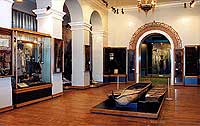 Museum
introduces the visitors the rich material and spiritual cultureof the
indigenous peoples in the Russian Far East at the turn of XIXth - XXth
centuries. It gives the opportunity to appreciate the variety of this
unique culture at its truevalue. Museum
introduces the visitors the rich material and spiritual cultureof the
indigenous peoples in the Russian Far East at the turn of XIXth - XXth
centuries. It gives the opportunity to appreciate the variety of this
unique culture at its truevalue.
The famous scientists and explorers P.P. Shimkevich,
Y.A. Sem, P.P. Kusmin, V.K. Arsenyev, V.P. Sysoev and even governor-generals
of the Priamursky Territory N.I. Grodekov, N.L. Gondatti and also research
workers of the museum have been forming the museum collections.
Today the 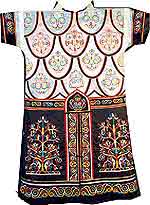 museum
reserves contain more than four thousand ethnographical items. Traditional
clothes and some household goods are represented in the first section.
Geographical location, various climate conditions, different works influenced
the originality of traditional clothes. museum
reserves contain more than four thousand ethnographical items. Traditional
clothes and some household goods are represented in the first section.
Geographical location, various climate conditions, different works influenced
the originality of traditional clothes.
Double fur-clothes of done up style was typical of peoples from the
Far North.
Visitors' attention is attracted by a Chukchy winter overall for
women "kerker" and a Koryak coat for men "kukhlyanka"
made of reindeer skin. The native peoples of Priamurye made their
clothes using skins of fish and animals. The unique exhibit is an
Ude dressing-gown made of skin of a Siberian salmon, dyed with infusion
of alder-tree bark and painted in water colours. A Nanai dressing-gown
for women is also of interest. It was made of a specially carried
reindeer skin called "rovduga".
An Aleut headdress hat-peak "chugudek",
brought to the museu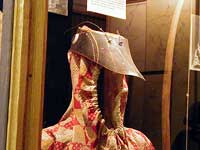 m
by V.K. Arsenyev, is of great scientific value. The number of beads
on its top means the number of killed animals. There are only two Aleut
headdresses with longitudinal ornament in the world. Similar to thisone
is the "chugudek" which is exposed in the Britain Museum in
London. m
by V.K. Arsenyev, is of great scientific value. The number of beads
on its top means the number of killed animals. There are only two Aleut
headdresses with longitudinal ornament in the world. Similar to thisone
is the "chugudek" which is exposed in the Britain Museum in
London.
Exhibits in the second section inform the visitors
on the material culture and different works of 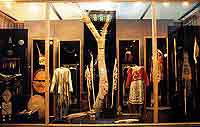 indigenous
peoples in the Khabarovsk Territory. Traditional hunting and fishing
tackle and some household articles of aborigines in Priamurye the Nanais,
Ulchies, Udes, Orochies, Nivkhs take an important place in the exposition.
Some kitchen utensils - dishes, vessels, boxes made of birch-bark, wicker
baskets, carved spoons make a strong impression on visitors. Fur clothes
of Evenks and Evens, a fur carpet, bags, a cradle characterize a nomadic
life of reindeerbreeders. indigenous
peoples in the Khabarovsk Territory. Traditional hunting and fishing
tackle and some household articles of aborigines in Priamurye the Nanais,
Ulchies, Udes, Orochies, Nivkhs take an important place in the exposition.
Some kitchen utensils - dishes, vessels, boxes made of birch-bark, wicker
baskets, carved spoons make a strong impression on visitors. Fur clothes
of Evenks and Evens, a fur carpet, bags, a cradle characterize a nomadic
life of reindeerbreeders.
Frame birch-bark and gouged boats, narrow and wide skis, a model of sledge
with the gear for 10 dogs were the main means of conveyance at that time.
The models of some temporary dwellings always compel
the attention of visitors. One of the dwellings, called "khemoran",
belongs to 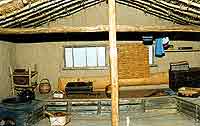 an
Ulchy fisherman, another, called "aonga", to a Nanai hunter.
On display one can also see an Evenk nomadic tent. A fragment of a Nanai
winter house equipped with an ancient heating system is reconstructed
in the exposition. Those heating systems were known in this territory
more than 2000 years ago. Big patriarchal families consisted of representatives
of some generations lived in houses like this one. The spiritual and
material culture (belief, family life, works, housekeeping) have been
formed during centuries. The native peoples were animists an
Ulchy fisherman, another, called "aonga", to a Nanai hunter.
On display one can also see an Evenk nomadic tent. A fragment of a Nanai
winter house equipped with an ancient heating system is reconstructed
in the exposition. Those heating systems were known in this territory
more than 2000 years ago. Big patriarchal families consisted of representatives
of some generations lived in houses like this one. The spiritual and
material culture (belief, family life, works, housekeeping) have been
formed during centuries. The native peoples were animists 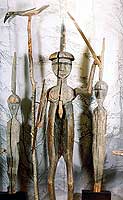 by
their belief. Different hunting and fishing cults were the most ancient
form of believes. Shamanism appeared later. Shamans were the mediators
between the material and spiritual worlds. Shamans' clothes and attributes
are represented in the section "Believes". Metallic plates
"toli", belts "yangpan", staffs, masks had to protect
a shaman against evil spirits. A ritual breastplate was necessary to
protect a voice of a shaman during ritual ceremonies. A tambourine symbolized
a sole of a shaman. The cult sculptures ("spirits-protectors"
and "spirits-assistants") are wide shown in the exposition. by
their belief. Different hunting and fishing cults were the most ancient
form of believes. Shamanism appeared later. Shamans were the mediators
between the material and spiritual worlds. Shamans' clothes and attributes
are represented in the section "Believes". Metallic plates
"toli", belts "yangpan", staffs, masks had to protect
a shaman against evil spirits. A ritual breastplate was necessary to
protect a voice of a shaman during ritual ceremonies. A tambourine symbolized
a sole of a shaman. The cult sculptures ("spirits-protectors"
and "spirits-assistants") are wide shown in the exposition.
The pride of the museum is the biggest complex of "spirits-protectors"
of an Ude shaman from the Kusun river. It was brought to the museum
by V.K. Arsenyev in 1911.
To the middle of the XXth century the traditional culture of indigenous
peoples changed very much. In present time it remains unique, but
in the whole we can get the information on it in museums only.
|





